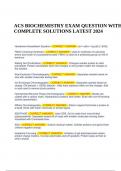Exam (elaborations)
ACS BIOCHEMISTRY EXAM QUESTION WITH COMPLETE SOLUTIONS LATEST 2024.
- Module
- Institution
ACS BIOCHEMISTRY EXAM QUESTION WITH COMPLETE SOLUTIONS LATEST 2024. Henderson-Hasselbach Equation - CORRECT ANSWER - pH = pKa + log ([A-] / [HA]) FMOC Chemical Synthesis - CORRECT ANSWER - Used in synthesis of a growing amino acid chain to a polystyrene bead. FMOC is used as a protecting group o...
[Show more]



